Combatting Stranger Aggression
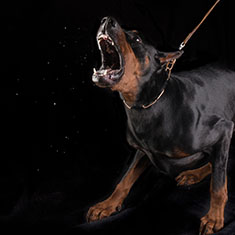
Separating Aggression from Exuberance
If your dog jumps up to greet people he may knock them over, but that doesn’t count as aggression. Even growling or barking can indicate wariness or excitement, but not necessarily aggression.
To judge aggression, you need to do some careful observations of your dog. There are three key indicators: posture, hackles, and muzzle. An aggressive dog’s posture typically includes leaning or lunging forward, possibly bending the legs to put the belly close to the ground, and the tail level with the body, held still. This stance prepares the dog to spring forward if there is a need to take the offensive.
The hackles, or the fur along the top of the neck, typically stands up when a dog feels threatened. The purpose of the raised hackles is to make the dog appear larger and, by extension, scarier to whomever is approaching.
Aggression is also indicated by bared teeth with a crinkled muzzle. Some dog show their teeth when they’re happy, but there is no associated wrinkling of the muzzle. The muzzle is a much better indicator of aggression than simply the showing of teeth.

Passive dogs, by contrast, will often show a posture of leaning back, preparing the dog for retreat. The tail is often held low or even curled under, and the hackles and muzzle are not raised.
One word of caution: fear is a common trigger for aggression, and a fearful dog may appear passive. This is where you must know your dog, or at least learn his “tells” quickly. If your dog goes from a fearful, passive stance directly to aggression (biting or attacking) even one time, you should consider your dog as potentially aggressive.
What About Provocation?
It’s true, many dogs become aggressive only after being provoked. However, because you may or may not know everything that will provoke your dog, you’ll need to work on anti-aggression measures to mitigate what the law will consider a known risk. If you are sued following a dog bite, and your dog has bitten even one person or animal in the past, any court in the country will likely say that you “knew or should have known” that the dog could be vicious and should have taken proper precautions.
Whether that means that the dog only goes outside when you are also out there to prevent the neighbor kids from throwing rocks, or if you don’t take your dog off of your property without a muzzle, you must do something to show that you are attempting to mitigate the risk of attack.
Socialization
The very best way to prevent aggression is to socialize your dog at a very young age. Socialization includes exposing your dog to a wide variety of stimuli and coaching him to give only appropriate responses.
For example, start by simply taking your puppy for a walk around the neighborhood and noticing what he reacts to, both good and bad. When he reacts well, such as by looking to you for guidance or by ignoring things that are inappropriate, reward him with attention and praise. When he over-reacts to something by barking or lunging, give a short tug on the leash and a sharp “no!”
Next, purposely expose your dog to the things that get him overly-excited, and reward small steps toward ignoring them. If on first exposure, he drags you after a squirrel for 30 yards, and on the 2nd try he only chases until he reaches the end of his leash, praise him for stopping, even if he continues to bark or raise his hackles. Keep exposing him to squirrels and rewarding each small step toward an acceptable response until he is capable of either ignoring or giving a minimal reaction to squirrels.
Be patient and make sure you have realistic expectations. A Beagle who has been bred for generations to track bunnies may or may not ever accomplish being able to totally ignore them. But you may be able to take that same Beagle and teach him to ignore the ducks at your local park.
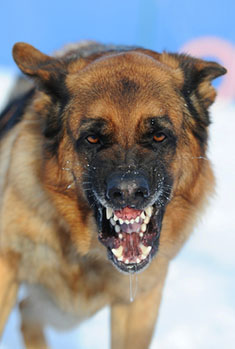
Preventing Stranger Aggression in Older Dogs
Although it’s a popular expression, it is totally untrue that “you can’t teach an old dog new tricks.” It’s never too late for your dog to learn to deal with his fears and other triggers for aggressive reactions. Use positive training methods such as what we outlined above, and you will eventually get there.
Prevention vs. Cure
If your dog is aggressive to the point where he is injuring people or other animals, you will need to make a decision as to whether or not you can afford the additional liability. You may want to add a dog rider to your homeowner’s policy or take out umbrella coverage. If you cannot afford the additional coverage, you may want to consider giving up the dog. You may choose to voluntarily surrender the animal to a shelter or rescue, in which case you MUST advise them that the dog has had previous aggression issues. Don’t risk having the dog re-homed with a child who could be seriously injured or even killed.
If you decide to keep your dog, there are steps you can take to lessen the risk of injury while you are working on socialization. Consider some of the following:
- Taller fence
- Locked gate
- Shorter, fixed-length leash (no retractables)
- Choke chain rather than flat collar
- Baby gates across doorways to rooms with exterior exits, to block escape into the yard
- Muzzle
- Crate to keep the dog separate from guests
- Limited exposure to upsetting stimuli
Doggies Den: Latest Articles
 Homemade Thanksgiving Treats for Your Dog
Homemade Thanksgiving Treats for Your Dog
NUTRITION We all want to include our dogs in our holiday celebrations, but hopefully, you're aware that sharing table scraps with your dog isn't always the best idea.
 Keeping Your Dog Safe during the Summer Months
Keeping Your Dog Safe during the Summer Months
HEALTH Summer is coming on fast, so it’s time to plan how you will keep your dog safe and healthy through the lazy, carefree, warm days.
 Vaccination Time Again-Keeping Your Puppy Healthy
Vaccination Time Again-Keeping Your Puppy Healthy
DOG HEALTH So you have your new puppy picked out. There are quite a few shots, treatments and examinations that will keep the newest member of your family healthy.
 Canine Thanksgiving Feast
Canine Thanksgiving Feast
NUTRITION With the wide variety of food at Thanksgiving dinner, chances are you'll want to give your dog something special, too. If you're contemplating what to feed your dog for the holiday, here is a guide to a great Canine Thanksgiving Feast.
 Dog Walking Tips Every Owner Should Know
Dog Walking Tips Every Owner Should Know
DOG FUN Walking your dog is not only crucial to keeping him healthy and happy, it strengthens the bond between your canine friend and his caregiver. There are a lot of obstacles out there. Don’t forget these simple tips to keep your walk fun and safe in the outside world.
 The Benefits of Physiotherapy for your Dog
The Benefits of Physiotherapy for your Dog
HEALTH The same techniques that physiotherapists use to treat a variety of injuries and conditions in humans have been adapted to suit animals with great success. Family pets, show dogs, and working dogs can all benefit greatly from physiotherapy. Dogs whose activities involve a lot of agility are especially susceptible to the types of problems that physiotherapy can address.
 The Decision- Adding a Dog to Your Family
The Decision- Adding a Dog to Your Family
FIRST TIME OWNERSBringing a dog into your family is a decision where many people don’t realize it’s magnitude until after they have the dog. There are a number of things that you need to research before you decide to purchase a dog, and it starts right in your own home.
 Bringing Your Dog Into Your New Baby's Life
Bringing Your Dog Into Your New Baby's Life
HEALTH Many believe that a dog and a new baby cannot happily coexist, so therefore the dog has to go. This is not necessarily the case.  A new baby does not mean you have to abandon your dog.

Doggies Den:
Most Popular Articles

Dog Pregnancy Symptoms
HEALTHIf you suspect your dog might be pregnant, check out part one in this series on pregnant dogs, where we cover pregnant dog symptoms.
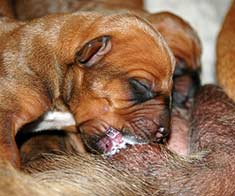
Dog Birth
HEALTHIn the third article of our dog pregnancy series, we look at the wonderful, but messy, process of bringing newborn puppies into the world.

Indoor Dog Potties
DOG PRODUCTSIt's been a long day at work. You were so busy, you didn't even take time to eat a sandwich, let alone run home to let your dog out. You're on your way home, knowing the poor dog is crossing his or her legs by now, when your car breaks down, delaying you even further. Can't somebody make this easier?
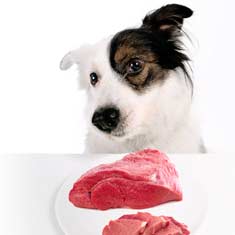
Your Dog’s Digestive System
PHYSIOLOGYEver wonder why your dog eats so fast? Or why he eats gross things? Or why he gets sick to his stomach? Or why his waste stinks so bad? Some of these things are normal, some are not.

Canine Respiratory System
BREATHINGThe basic function of your dog's respiratory system is to bring oxygen in to and remove carbon dioxide from the body. Knowing the symptoms of respiratory diseases can help you help your stay healthy.
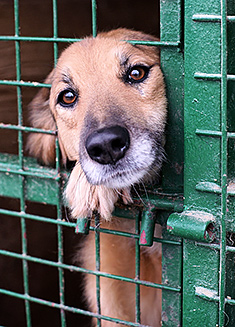
Shelter Dog Adoption Tips for Success
ADOPTION Are you intimidated by the prospect of "rescuing" a dog from a shelter? One reason that you may be wary of adopting a dog from a shelter is not knowing how to choose. Adopting a dog from a shelter can be a rewarding process, if you're prepared to do a reasonable amount of research.

Canine Urinary Tract Infections
SYMPTOMS AND TREATMENTDoes your dog seem to be having trouble relieving his or her bladder? Learn how to recognize the signs of urinary tract infections and how to treat them before they spread.

What to do for Dog Diarrhea
SYMPTOMS AND REMEDIESIf you have dogs in your house for any length of time, you have likely experienced at least one bout of dog diarrhea. Beyond the pain in the tuckus involved in cleaning up the mess, you should know what causes diarrhea, and when it's important to see the vet.
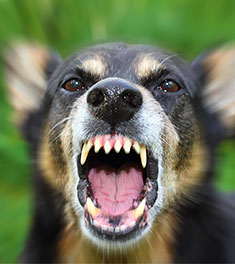
What to do for a Dog Bite
DOG BEHAVIOR Getting bitten by a dog can be scary, and you may be tempted to run around in circles for a while, trying to figure out what to do. Here's our guide to help you manage the situation.

Top Ten Tips for Living with a Senior Dog
DOG HEALTH Bringing home a new puppy is so exciting, but it doesn’t take all that long for your exuberant puppy to grow into a senior dog who may have special needs. Here are the doggies.com top ten tips for taking care of your companion who has been with you through so much.
